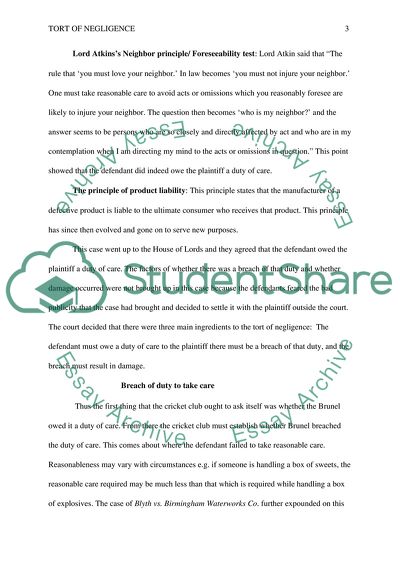Cite this document
(Tort of Negligence Report Example | Topics and Well Written Essays - 2000 words, n.d.)
Tort of Negligence Report Example | Topics and Well Written Essays - 2000 words. https://studentshare.org/law/1762916-castle-cricket-club-ccc-has-in-recent-years-become-very-popular-and-so-wanted-to-increase-the-number-of-seats-available-for-spectators-brunel-a-structural-engineer-and-ccc-committee-member-agreed-free-of-charge-to-design-a-further-level-on-the-curr
Tort of Negligence Report Example | Topics and Well Written Essays - 2000 words. https://studentshare.org/law/1762916-castle-cricket-club-ccc-has-in-recent-years-become-very-popular-and-so-wanted-to-increase-the-number-of-seats-available-for-spectators-brunel-a-structural-engineer-and-ccc-committee-member-agreed-free-of-charge-to-design-a-further-level-on-the-curr
(Tort of Negligence Report Example | Topics and Well Written Essays - 2000 Words)
Tort of Negligence Report Example | Topics and Well Written Essays - 2000 Words. https://studentshare.org/law/1762916-castle-cricket-club-ccc-has-in-recent-years-become-very-popular-and-so-wanted-to-increase-the-number-of-seats-available-for-spectators-brunel-a-structural-engineer-and-ccc-committee-member-agreed-free-of-charge-to-design-a-further-level-on-the-curr.
Tort of Negligence Report Example | Topics and Well Written Essays - 2000 Words. https://studentshare.org/law/1762916-castle-cricket-club-ccc-has-in-recent-years-become-very-popular-and-so-wanted-to-increase-the-number-of-seats-available-for-spectators-brunel-a-structural-engineer-and-ccc-committee-member-agreed-free-of-charge-to-design-a-further-level-on-the-curr.
“Tort of Negligence Report Example | Topics and Well Written Essays - 2000 Words”. https://studentshare.org/law/1762916-castle-cricket-club-ccc-has-in-recent-years-become-very-popular-and-so-wanted-to-increase-the-number-of-seats-available-for-spectators-brunel-a-structural-engineer-and-ccc-committee-member-agreed-free-of-charge-to-design-a-further-level-on-the-curr.


